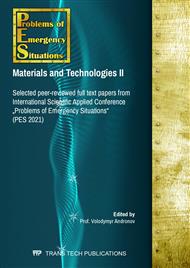[1]
V.Iurchenko, O.Melnikova, A.Bakhareva, M.Yachnyk, Research of mechanical treatment of stormwater runoffs formed on objects of automobile and road complex, Eastern-European Journal of Enterprise Technologies. 6/6 (78) (2015) 71-77.
DOI: 10.15587/1729-4061.2015.55427
Google Scholar
[2]
Yu. Zelenko, M. Malovanyy, L.Tarasova, Оptimization of heat-and-power plants water purification, Chemistry&Chemical Technology. 13(2) (2019) 218–223.
Google Scholar
[3]
M. Malovanyy, H.Sakalova, T.Vasylinycz, O.Palamarchuk, Ja.Semchuk, Treatment of Effluents from Ions of Heavy Metals as Display of Environmentally Responsible Activity of Modern Businessman, Journal of Ecological Engineering. 20(4) (2019) 167–176.
DOI: 10.12911/22998993/102841
Google Scholar
[4]
E. Kostenko, L.Melnyk, S.Matko, M.Malovanyy, The use of sulphophtalein dyes immobilized on anionite Ab-17X8 to determine the contents of Pb(Ii), Cu(Ii), Hg(Ii) and Zn(Ii) in liquid medium, Chemistry&Chemical Technology. 11(1) (2017) 117-124.
DOI: 10.23939/chcht11.01.117
Google Scholar
[5]
M.Malovanyy, K.Petrushka, I.Petrushka, Improvement of Adsorption-Ion-Exchange Processes for Waste and Mine Water Purification, Chemistry & Chemical Technology. 13(3) (2019) 372–376.
DOI: 10.23939/chcht13.03.372
Google Scholar
[6]
H.Sakalova, M.Malovanyy, T.Vasylinych, R.Kryklyvyi, The Research of Ammonium Concentrations in City Stocks and Further Sedimentation of Ion-Exchange Concentrate, Journal of Ecological Engineering, 20(1) (2019) 158-164.
DOI: 10.12911/22998993/93944
Google Scholar
[7]
M. Inagaki, F.Kang, Materials Science and Engineering of Carbon. Fundamentals, 2nd Ed. Elsevier, Butterworth- Heinemann, (2014).
Google Scholar
[8]
L.F. Delgado, P.Charles, K.Glucina, C.Morlay, The removal of endocrine disrupting compounds, pharmaceutically activated compounds and cyanobacterial toxins during drinking water preparation using activated carbon - a review, Sci. Total Environ. 435 (2012) 509-525.
DOI: 10.1016/j.scitotenv.2012.07.046
Google Scholar
[9]
A.Bhatnagar, W.Hogland, M.Marques, M.Sillanpää, An overview of the modification methods of activated carbon for its water treatment applications, Chemical Engineering Journal. 219 (2013) 499-511.
DOI: 10.1016/j.cej.2012.12.038
Google Scholar
[10]
P.Gonżalez-Garcia, Activated carbon from lignocellulosics precursors: A review of the synthesis methods, characterization techniques and applications, Renewable and Sustainable Energy Reviews. 82 (2018) 1393-1414.
DOI: 10.1016/j.rser.2017.04.117
Google Scholar
[11]
E.Greiner, T.Kalin, Y.Inoguchi, Marketing Research Report: Activated Carbon, Chemical Economic Handbook. (2010) 5.
Google Scholar
[12]
Y.Danchenko, V.Andronov, А.Kariev, V.Lebedev, E.Rybka, R.Meleshchenko, D. Yavorska, Research into surface properties of disperse fillers based on plant raw materials, Eastern-European Journal of Enterprise Technologies. 5/12(89) (2017) 20-26.
DOI: 10.15587/1729-4061.2017.111350
Google Scholar
[13]
M.A. Yahya, Z.Al-Qodah, C.Z. Ngah, Agricultural bio-waste materials as potential sustainable precursors used for activated carbon production: a review, Renewable and Sustainable Energy Reviews. 46 (2015) 218-235.
DOI: 10.1016/j.rser.2015.02.051
Google Scholar
[14]
Tan Xiao-fei, Liu Shao-bo, Liu Yun-guo, Y-l.Gu, G-m.Zeng, X-j.Hu, X.Wang, S-h.Liu, L-h.Jiang, Biochar as potential sustainable precursors for activated carbon production: multiple applications in environmental protection and energy storage, Bioresource Technology. 227 (2017) 359-372.
DOI: 10.1016/j.biortech.2016.12.083
Google Scholar
[15]
F.Regisser, M.-A.Lavoie, G.Y. Champagne, D.Belanger, Randomly oriented graphite electrode. Part 1. Effect of electrochemical pretreatment on the electrochemical behavior and chemical composition of electrode, J. Electroanal. Chem. 415 (1996) 47-54.
DOI: 10.1016/s0022-0728(96)04636-0
Google Scholar
[16]
Ma X.Zhou, Ch.Song, Effects of oxidative modification of carbon surface on the adsorption of sulfur compounds in diesel fuel, Applied Catalysis B: Environmental. 87(3-4) (2009) 190-199.
DOI: 10.1016/j.apcatb.2008.09.024
Google Scholar
[17]
Kumar Singh Ashutosh, Yasri Nael, Karan Kunal, E.P.L. Roberts, Effect of pretreatment on Carbon Materials, ECS Meet. Abstr. MA2018-01 (2018) 2391.
DOI: 10.1149/ma2018-01/41/2391
Google Scholar
[18]
V. Ptashnyk, I. Bordun, M. Malovanyy, P. Chabecki, T. Pieshkov, The change of structural parameters of nanoporous activated carbons under the influence of ultrasonic radiation, Applied Nanoscience. 10(2) (2020) 4891-4899.
DOI: 10.1007/s13204-020-01393-z
Google Scholar
[19]
Ch.Xia, S.Q. Shi, Self-activation for activated carbon from biomass: theory and parameters, Green Chemistry. 18(7) (2016) 2063-2071.
DOI: 10.1039/c5gc02152a
Google Scholar
[20]
K.Li, Z.Zheng, Y.Li, Characterization and lead adsorption properties of activated carbons prepared from cotton stalk by one-step H3PO4 activation. J. Hazard Matter. 181 (2010) 440-447.
DOI: 10.1016/j.jhazmat.2010.05.030
Google Scholar
[21]
G.Chu, J.Zhao, Y.Huang, et al., Phosphoric acid pretreatment enhances the specific surface areas of biochars by generation of micropores, Environmental Pollution. 240 (2018) 1-9.
DOI: 10.1016/j.envpol.2018.04.003
Google Scholar
[22]
S.M. Yakont, El-Deen G.Sharaf, Characterization of activated carbon prepared by phosphoric acid activation of olive stones, Arabian Journal of Chemistry. 9 (2016) 155-162.
DOI: 10.1016/j.arabjc.2011.12.002
Google Scholar
[23]
J.Wang, F.-A.Wu, M.Wang, et al., Preparation of activated carbon from a renewable agricultural residue of pruning mulberry shoot, African Journal of Biotechnology. 9(19) (2010) 2762-2767.
Google Scholar
[24]
M.S. Shamsuddin, N.R.N. Yusoff, M.A. Sulaiman, Synthesis and characterization of activated carbon produced from kenaf core fiber using H3PO4 activation, Procedia Chemistry. 19 (2016) 558-565.
DOI: 10.1016/j.proche.2016.03.053
Google Scholar
[25]
D.F. Karchevskiy, A.A. Beushev M.M. Chemeris, RU Patent 2323878 (2008).
Google Scholar
[26]
M.Inagaki, Structure and texture of carbon materials, іn F.Beguin, E.Frackowiak (Eds.), Carbon for Electrochemical Energy Storage Systems, CRC Press Taylor and Francis Group, New York, (2002).
Google Scholar
[27]
Mandziuk V. I., Lisovskyi R. P., Nahirna N. I., Rachii B. I., Struktura porystykh vuhletsevykh materialiv zghidno metodu adsorbtsii/desorbtsii azotu, Fizychna inzheneriia poverkhni. 11(1) (2013) 112-121.
Google Scholar
[28]
S.J. Gregg, K.S.W. Sing, Adsorption, Surface Area and Porosity, second ed., Academic Press, London, (1982).
Google Scholar


